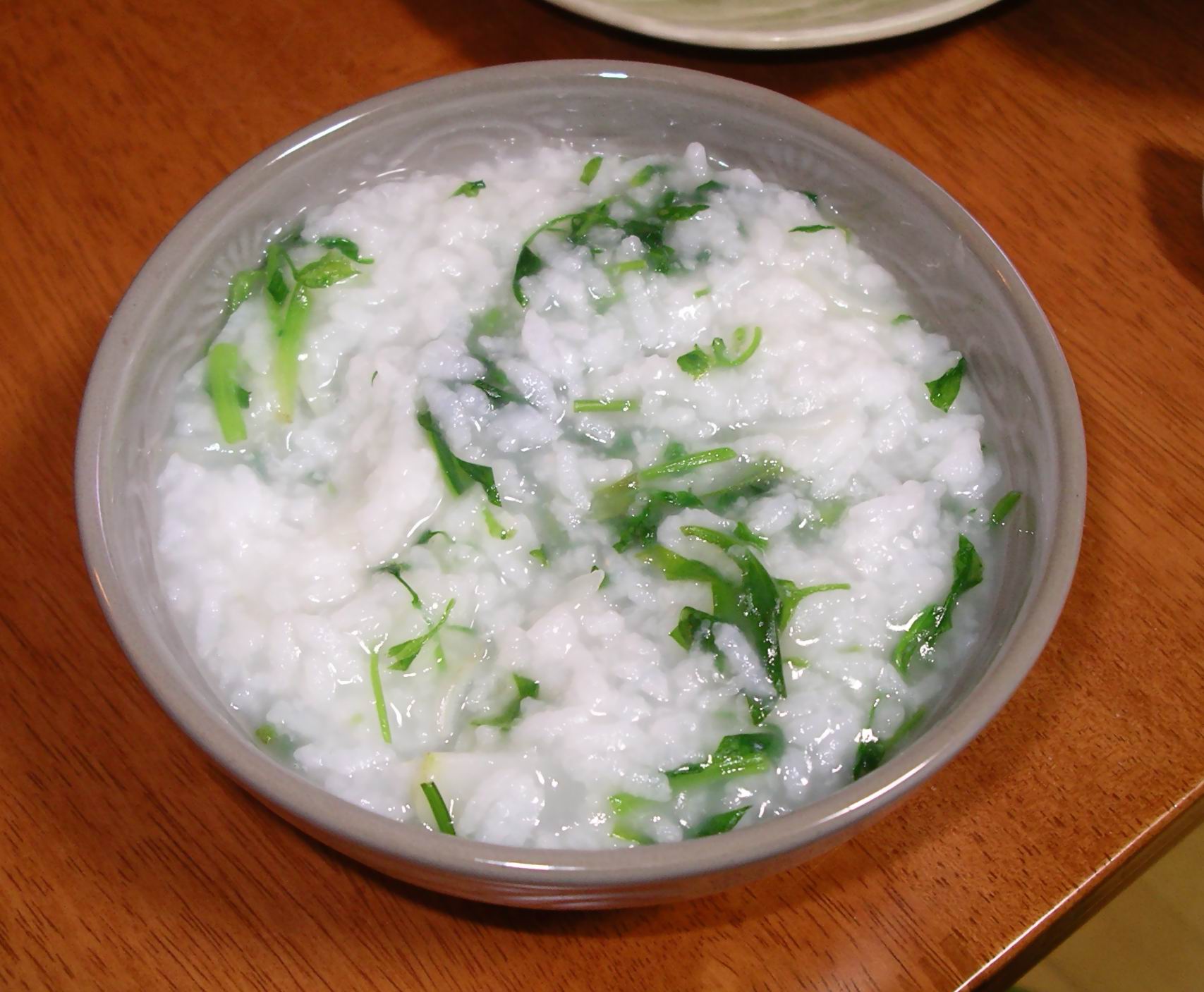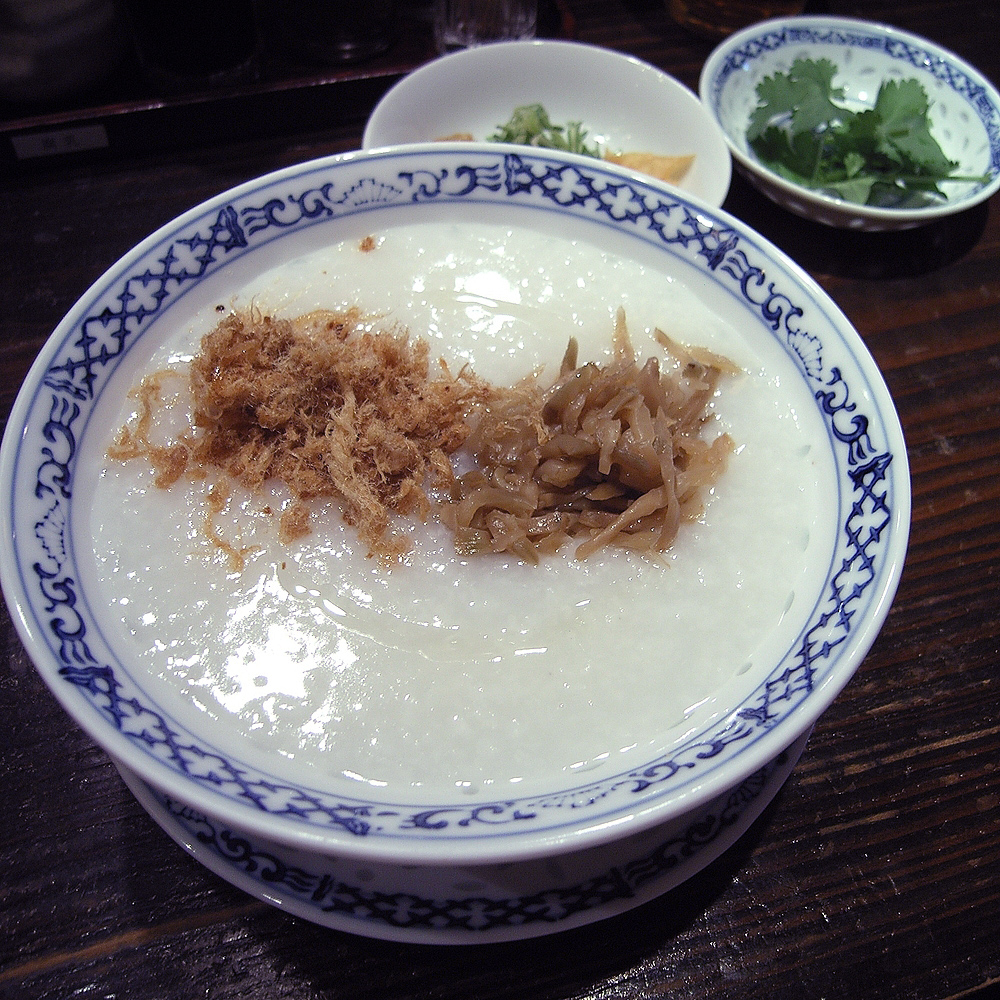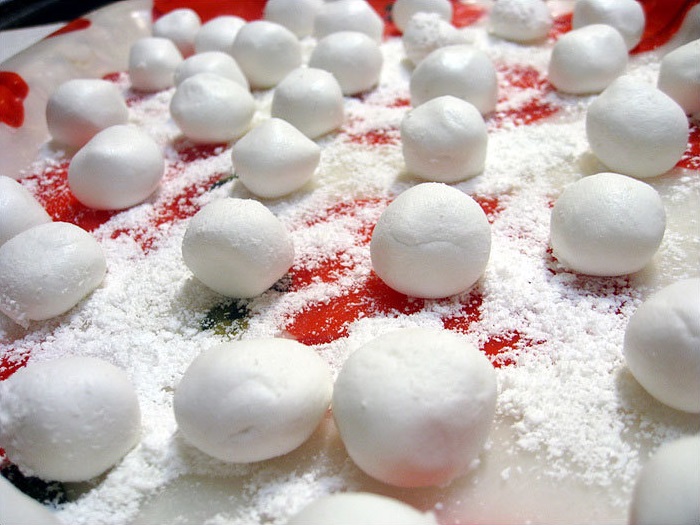|
Hobak-juk
''Hobak-juk'' () or pumpkin porridge, is a variety of Korean porridge, or ''juk'', made with pumpkin and glutinous rice flour. * Recovering patients or the elderly traditionally receive this smooth and naturally sweet porridge. Preparation Pumpkins, preferably Korean cheese pumpkins called ''cheongdung-hobak'' () or kabocha squash called ''danhobak'' (), are washed and sliced into thick pieces. It is boiled, peeled, deseeded, and mashed. Mashed pumpkin can be strained to obtain a smoother texture. It is then mixed with glutinous rice flour slurry and boiled, during which parboiled red beans or black beans may be added. Another common addition is ''saealsim'' (; literally "bird's egg", named as such due to its resemblance to small bird's eggs, possibly quail eggs), the small rice cake balls made of glutinous rice flour kneaded with hot water. Finally, salt and, optionally, sugar are added to taste. See also * '' Patjuk'' * Pumpkin soup * List of porridges * List of squ ... [...More Info...] [...Related Items...] OR: [Wikipedia] [Google] [Baidu] |
List Of Squash And Pumpkin Dishes
This is a list of notable squash and pumpkin dishes that are prepared using Cucurbita, squash and pumpkin as a primary ingredient. Pumpkin is a squash cultivar. Squash and pumpkin dishes and foods * ''Hobak-juk'' – a Korean variety of ''juk (food), juk'' (porridge) made with pumpkin and glutinous rice flour. * It is a smooth and naturally sweet porridge that is traditionally served to the elderly or recovering patients. * Hobak-tteok – a Korean dish and variety of ''siru-tteok'' (steamed rice cake) made by mixing fresh or dried pumpkin with glutinous or non-glutinous rice flour, then steaming the mixture in a ''siru'' (rice cake steamer). * Kadu bouranee – an Afghan and Turkish dish made by frying pumpkin with different spices * Maraq (dish), Maraq – a Somali soup that is sometimes prepared using pumpkin * Mashed pumpkin – a vegetable dish made by cooking or macerating the skinless flesh (pulp) of pumpkins and then mashing, straining, grinding, or puréeing until the ... [...More Info...] [...Related Items...] OR: [Wikipedia] [Google] [Baidu] |
Juk (food)
Congee ( , derived from Tamil ), is a form of savoury rice porridge made by boiling rice in a large amount of water until the rice softens. Depending on rice–water ratio, the thickness of congee varies from a Western oatmeal porridge to a gruel. Since the history of rice cultivation in Asia stretches back to the Baiyue-inhabited lower Yangtze circa 10,000 BC, congee is unlikely to have appeared before that date. Congee is typically served with side dishes, or it can be topped with meat, fish, and pickled vegetables. Vivid experiences of eating or delivering thin congee as wartime or famine food often feature in diaries and chronicles. In some cultures, congee is eaten primarily as a breakfast food or late supper; some may also eat it as a substitute for rice at other meals. It is often considered suitable for the sick as a mild, easily digestible food. Etymology The popular English name ''congee'' derives from the Tamil word (''kañci''). The Portuguese adopted the ... [...More Info...] [...Related Items...] OR: [Wikipedia] [Google] [Baidu] |
Pumpkin Soup
Pumpkin soup is a usually 'bound' (thick) soup made from a purée of pumpkin. It is made by combining the meat of a blended pumpkin with broth or stock. It can be served hot or cold, and is a common Thanksgiving dish in the United States. Various versions of the dish are known in many European countries, the United States and other areas of North America, in Asia and in Australia. Pumpkin soup was a staple for the prisoners of war in North Vietnamese prison camps during the Vietnam War. Squash soup is a soup prepared using squash as a primary ingredient. Squash used to prepare the soup commonly includes acorn and butternut squash. Preparation Squash that has initially been separately roasted can be used in soup preparation. The roasting of squash can serve to concentrate the gourd's flavor. Squash soup can be prepared with chunks or pieces of squash and also with puréed squash. Pre-cooked, frozen squash can also be used, as can commercially prepared packets of pre-cooked fro ... [...More Info...] [...Related Items...] OR: [Wikipedia] [Google] [Baidu] |
Juk (food)
Congee ( , derived from Tamil ), is a form of savoury rice porridge made by boiling rice in a large amount of water until the rice softens. Depending on rice–water ratio, the thickness of congee varies from a Western oatmeal porridge to a gruel. Since the history of rice cultivation in Asia stretches back to the Baiyue-inhabited lower Yangtze circa 10,000 BC, congee is unlikely to have appeared before that date. Congee is typically served with side dishes, or it can be topped with meat, fish, and pickled vegetables. Vivid experiences of eating or delivering thin congee as wartime or famine food often feature in diaries and chronicles. In some cultures, congee is eaten primarily as a breakfast food or late supper; some may also eat it as a substitute for rice at other meals. It is often considered suitable for the sick as a mild, easily digestible food. Etymology The popular English name ''congee'' derives from the Tamil word (''kañci''). The Portuguese adopted the ... [...More Info...] [...Related Items...] OR: [Wikipedia] [Google] [Baidu] |
Cucurbita Moschata
''Cucurbita moschata'' is a species originating in the tropical Americas which is cultivated for edible flesh, flowers, greens, and seeds. It includes cultivars known in English as squash or pumpkin. Cultivars of ''C. moschata'' are generally more tolerant of hot, humid weather than squash of other domesticated species. C. moschata also exhibit a greater resistance to certain disease and insects, notably including to the squash vine borer. Commercially made pumpkin pie mix is most often made from varieties of ''C. moschata''. History All species of squashes and pumpkins are native to the Western Hemisphere, and the ancestral members of the genus '' Cucurbita'' were present in the Americas before humans.Victor E. Boswell and Else Bostelmann. "Our Vegetable Travelers." ''The National Geographic Magazine.'' 96.2: August 1949. Squash are important food plants of the original people of the region, ranking next to maize and beans in many precolonial American economies. In the modern ... [...More Info...] [...Related Items...] OR: [Wikipedia] [Google] [Baidu] |
List Of Porridges
Porridge is a dish made by boiling ground, crushed, or chopped starchy plants (typically grains) in water, milk, or both, with optional flavorings, and is usually served hot in a bowl or dish. It may be served as a sweet or savory dish, depending on the flavourings. Porridges A * Atole traditional masa-based hot maize based beverage of Mexican cuisine, Mexican and Latin American cuisine, Central American origin. It includes masa (corn hominy flour), water, piloncillo (unrefined cane sugar), cinnamon, vanilla and optional chocolate or fruit. The mixture is blended and heated before serving. * Avena (drink) prepared with stewed oatmeal, milk, water, cinnamon, clove and sugar *Arroz caldo, Arroz caldo or aroskaldo – a variant of congee in Filipino cuisine, Philippine cuisine. B * Barley gruel type of porridge found in Danyang, Jiangsu. It is made from barley, rice and alkali. * Belila (porridge), Belila is an Egyptian porridge made from pearl wheat, cooked in a light syrup with ... [...More Info...] [...Related Items...] OR: [Wikipedia] [Google] [Baidu] |
Patjuk
''Patjuk'' () is a type of Korean juk consisting of red beans and rice. It is commonly eaten during the winter season in Korea, and it is associated with '' dongji'' (winter solstice), * as people used to believe that the red color of ''patjuk'' drives off baneful spirits. Preparation Dried red beans are boiled with eight to ten parts water until fully cooked and soft, then mashed and passed through a sieve. The bean skins are discarded, and the remaining beans sit for some time in order for them to separate into layers. The upper layer consisting of clear water is used to boil rice, while the lower layer consisting of settled red bean mash is kept. When the rice is cooked, the mashed beans are added back into the porridge along with ''saeal-sim'' (; literally "bird's egg", named as such due to its resemblance to small bird's eggs, possibly quail eggs), which are the small rice cake balls made of glutinous rice flour. The number of ''saealsim'' added is often the same number ... [...More Info...] [...Related Items...] OR: [Wikipedia] [Google] [Baidu] |
Quail Eggs
Quail eggs or quails' eggs (British English) are a kind of eggs as food, eaten and considered a delicacy in many parts of the world, including Asia, Europe, and North America. In Japanese cuisine, they are sometimes used raw or cooked as ''tamago'' in sushi and often found in '' bento'' lunches. In some other countries, eggs of quail are considered less exotic. In Brazil, Colombia, Ecuador, and Venezuela, a single hard-boiled quail egg is a common topping on hot dogs and hamburgers, often fixed into place with a toothpick. In the Philippines, '' kwek-kwek'' is a popular street-food delicacy, which consists of soft-boiled quail eggs dipped in orange-colored batter before being skewered and deep-fried. In Indonesia, small packages of hard-boiled quail eggs are sold by street vendors as snacks, and skewered quail eggs are sold as '' satay'' to accompany main dishes such as '' soto'' and '' bubur ayam''. In Vietnam, bags of boiled quail eggs are sold on street stalls as i ... [...More Info...] [...Related Items...] OR: [Wikipedia] [Google] [Baidu] |
Soybean
The soybean, soy bean, or soya bean (''Glycine max'') is a species of legume native to East Asia, widely grown for its edible bean. Soy is a staple crop, the world's most grown legume, and an important animal feed. Soy is a key source of food, useful both for its protein and oil content. Soybean oil is widely used in cooking, as well as in industry. Traditional unfermented food uses of soybeans include edamame, as well as soy milk, from which tofu and tofu skin are made. Fermented soy foods include soy sauce, fermented bean paste, nattō, and tempeh. Fat-free (defatted) soybean meal is a significant and cheap source of protein for animal feeds and many packaged meals. For example, soybean products, such as textured vegetable protein (TVP), are ingredients in many meat and dairy substitutes. Soy based foods are traditionally associated with East Asian cuisines, and still constitute a major part of East Asian diets, but processed soy products are increasingly used ... [...More Info...] [...Related Items...] OR: [Wikipedia] [Google] [Baidu] |
Adzuki Bean
''Vigna angularis'', also known as the , azuki bean, aduki bean, red bean, or red mung bean, is an Annual plant, annual vine widely cultivated throughout East Asia for its small (approximately long) bean. The cultivars most familiar in East Asia have a uniform red color, but there are white, Black adzuki bean, black, gray, and variously mottled varieties. Scientists presume ''Vigna angularis'' var. ''nipponensis'' is the progenitor. Origin and diversity Speciation and domestication The wild ancestor of cultivated adzuki bean is probably ''Vigna angularis'' var. ''nipponensis'', which is distributed across East Asia. Speciation between ''Vigna angularis'' var. ''nipponensis'' and ''Vigna angularis'' var. ''angularis'' occurred around years ago. Wild adzuki likely originated near the Himalayas and spread naturally to central China and Japan. Archaeologists estimate it was domesticated around 3000 BC. However, adzuki beans, as well as soybeans, dating from 3000 BC to 2000 ... [...More Info...] [...Related Items...] OR: [Wikipedia] [Google] [Baidu] |
Doosan Corporation
Doosan Corporation () is a corporate holding company headquartered in Euljiro 6-ga, Jung-gu, Seoul, South Korea. History * 1896 Park Seung-jik opened Korea's first modern dry goods store, selling cloth. * 1925 Changed the name of Park Seung-Jik Store Limited to Doosan Store * 1953 Established the Oriental Brewery and began producing OB beer. * 1960 Established Dongsan Construction and Engineering (currently Doosan Engineering & Construction)/Acquired Hapdong News Agency (currently Yonhap News) * 1966 Founded Hanyang Food * 1967 Founded Yoonhan Machinery (currently Doosan Mecatec) * 1969 Founded Hankook Bottle and Glass * 1979 Established Doosan CCK Can Manufacturing * 1980 Founded OB Seagram * 1982 Formed OB Bears (currently Doosan Bears) * 1996 Celebrated 100th anniversary. Announced Doosan Group's new Certificate of Incorporation. * 1998 Incorporated nine affiliates and re-launched the company as Doosan Corporation in September. * 2008 Acquired the Chung-Ang University Founda ... [...More Info...] [...Related Items...] OR: [Wikipedia] [Google] [Baidu] |
Doopedia
''Doosan Encyclopedia'' () is a Korean-language encyclopedia published by Doosan Donga (). The encyclopedia is based on the ''Dong-A Color Encyclopedia'' (), which comprises 30 volumes and began to be published in 1982 by Dong-A Publishing (). Dong-A Publishing was merged into Doosan Donga, a subsidiary of Doosan Group, in February 1985. The ''Doosan Encyclopedia'' is a major encyclopedia in South Korea. Digital edition EnCyber The online version of the ''Doosan Encyclopedia'' was named EnCyber, which is a blend of two English words: ''Encyclopedia'' and ''Cyber''. The company has stated that, with the trademark, it aims to become a center of living knowledge. EnCyber provides free content to readers via South Korean portals such as Naver. Naver has risen to the top position in the search engine market of South Korea partially because of the popularity of EnCyber encyclopedia. When Naver exclusively contracted Doosan Doonga in 2003, the former paid multi billion won to the ... [...More Info...] [...Related Items...] OR: [Wikipedia] [Google] [Baidu] |





